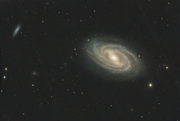| Messier 109 | |
|---|---|
 Messier 109, as imaged during the Advanced Observing Program Messier 109, as imaged during the Advanced Observing Program | |
| Observation data (J2000 epoch) | |
| Constellation | Ursa Major |
| Right ascension | 11 57 36.0 |
| Declination | +53° 22′ 28″ |
| Redshift | 0.003496±0.000004 |
| Heliocentric radial velocity | 1048±1 km/s |
| Galactocentric velocity | 1121±3 km/s |
| Distance | 67.2 ± 23.2 Mly (20.6 ± 7.1 Mpc) |
| Apparent magnitude (V) | 9.8 |
| Characteristics | |
| Type | SB(rs)bc, LINER/HII |
| Apparent size (V) | 7.6 × 4.7 moa |
| Other designations | |
| IRAS 11549+5339, NGC 3992, UGC 6937, MCG +09-20-044, PGC 37617 | |
| References: SIMBAD: Search M109 | |
Messier 109 (also known as NGC 3992 or the Vacuum Cleaner Galaxy) is a barred spiral galaxy exhibiting a weak inner ring structure around the central bar approximately 67.2 ± 23 million light-years away in the northern constellation Ursa Major. M109 can be seen south-east of the star Phecda (γ UMa, Gamma Ursa Majoris).
History
Messier 109 was discovered by Pierre Méchain in 1781. Two years later Charles Messier catalogued the object, as an appended object to his publication.
Between the 1920s through the 1950s, it was considered that Messier objects over 103 were not official, but later the additions, further referred target objects from Méchain, became more widely accepted. David H. Levy mentions the modern 110 object catalog while Sir Patrick Moore places the limit at 104 objects but has M105 to 109 listed as addenda. By the late 1970s all 110 objects are commonly used among astronomers and remain so.
General information
This galaxy is the most distant object in the Messier Catalog, followed by M91.
M109 has three satellite galaxies (UGC 6923, UGC 6940 and UGC 6969) and possibly more. Detailed hydrogen line observations have been obtained from M109 and its satellites. M109's H I (H one) distribution is regular with a low-level radial extension outside the stellar disc, while in the bar is a central H I hole in the gas distribution. Possibly the gas has been transported inwards by the bar, and because of the emptiness of the hole no large accretion events can have happened in the recent past.
M109 is the brightest galaxy in the M109 Group, a large group of galaxies in the constellation Ursa Major that may number over 50.
Supernova
One supernova has been observed in M109: SN 1956A (type Ia, mag. 12.3) was discovered by H. S. Gates on 8 March 1956, using the 18-inch Schmidt telescope at the Palomar Observatory. It was located 67" east and 9" south of the center of the galaxy.
Gallery
-
 M109 NGC3992, J87 Observatory
M109 NGC3992, J87 Observatory
-
 Amateur image of Messier 109
Amateur image of Messier 109
-
 Core of galaxy M109, Hubble image captured by Wide Field Camera 3
Core of galaxy M109, Hubble image captured by Wide Field Camera 3
-
 Finder chart for galaxy Messier 109 (circled in blue)
Finder chart for galaxy Messier 109 (circled in blue)
See also
- List of Messier objects
- NGC 1300 – a similar barred spiral galaxy
References
- Kaufmann, D.E.; Contopoulos, G. (1996). "Self-consistent models of barred spiral galaxies". Astronomy & Astrophysics. 309: 381–402. Bibcode:1996A&A...309..381K.
- ^ "NASA/IPAC Extragalactic Database". Results for M 109. Retrieved 2006-10-10.
- "Messier 109". SEDS Messier Catalog. Retrieved 30 April 2022.
- "Distance Results for MESSIER 109". NASA/IPAC Extragalactic Database. Retrieved 2023-04-03.
- Bottema, Roelof; Verheijen (2002). "Dark and luminous matter in the NGC 3992 group of galaxies". Astronomy and Astrophysics. 388 (3): 793. arXiv:astro-ph/0204335. Bibcode:2002A&A...388..793B. doi:10.1051/0004-6361:20020539. S2CID 119374710.
- R. B. Tully (1988). Nearby Galaxies Catalog. Cambridge University Press. ISBN 978-0-521-35299-4.
- P. Fouque; E. Gourgoulhon; P. Chamaraux; G. Paturel (1992). "Groups of galaxies within 80 Mpc. II - The catalogue of groups and group members". Astronomy and Astrophysics Supplement. 93: 211–233. Bibcode:1992A&AS...93..211F.
- A. Garcia (1993). "General study of group membership. II - Determination of nearby groups". Astronomy and Astrophysics Supplement. 100: 47–90. Bibcode:1993A&AS..100...47G.
- G. Giuricin; C. Marinoni; L. Ceriani; A. Pisani (2000). "Nearby Optical Galaxies: Selection of the Sample and Identification of Groups". Astrophysical Journal. 543 (1): 178–194. arXiv:astro-ph/0001140. Bibcode:2000ApJ...543..178G. doi:10.1086/317070. S2CID 9618325.
- "SN 1956A". Transient Name Server. IAU. Retrieved 27 November 2024.
- Zwicky, F.; Karpowicz, Maria (1964). "Supernova 1956a of type I in NGC 3992". The Astronomical Journal. 69: 759. Bibcode:1964AJ.....69..759Z. doi:10.1086/109352.
External links
- "Messier 109". SEDS. Retrieved 2005-08-11.
- Messier 109 on WikiSky: DSS2, SDSS, GALEX, IRAS, Hydrogen α, X-Ray, Astrophoto, Sky Map, Articles and images
- M109
| Messier objects | ||
|---|---|---|
| List |
|  |
| See also | ||